An Inquiry into the Characteristics of Carbon Emissions in Inter-Provincial Transportation in China: Aiming to Typological Strategies for Carbon Reduction in Regional Transportation
Abstract
:1. Introduction
2. Materials and Methods
2.1. Data Sources
2.2. Multi-Indicator Joint Characterization Method for Provincial TCO2 Characteristics
2.2.1. Construction Process of Characteristic Indicators
2.2.2. Definition of Characteristic Indicators
2.3. Hierarchical Cluster Analysis following Ward’s Method
2.4. Transportation CO2 Emissions Calculation Methods
2.5. Correlation Analysis between Characterization Indicators and the Direct Quantity of TCO2
3. Results and Discussion
3.1. Results of Characteristic Indicator Calculation and Cluster Analysis
3.2. Analysis of Provincial Type Characteristics
3.3. Calculation Results of Provincial TCO2
3.4. Correlation Analysis Results of Characterization Indicators with the per Capita TCO2 and the Intensity of TCO2
3.4.1. The Correlation Analysis Results between TP and Characteristic Indicators
3.4.2. The Correlation Analysis Results between TI and Characteristic Indicators
3.5. Carbon Reduction Strategies and KPIs for Provincial Types
3.5.1. Carbon Reduction Strategies for Provincial Types
3.5.2. Carbon Reduction KPIs for Provincial Types
4. Conclusions and Policy Implications
- (1)
- Optimizing traffic congestion, controlling the number of fuel-powered private vehicles, and advocating low-carbon residents’ behaviors are important measures to effectively control the direct quantity of TCO2 (TC, TI, and TP). Provinces categorized as Type I, Type II, and Type IV should primarily optimize urban vehicle restriction policies and conduct reasonable adjustments in urban spatial planning (such as industrial layout, development of industrial parks, establishment of employment centers, educational layout, and planning multifunctional community areas) to fundamentally address urban traffic congestion issues. Provinces identified as Type IV and Type V should enhance the coverage and service efficiency of public transportation systems (such as bus rapid transit and dedicated bus lanes). Provinces classified as Type I and Type II, benefiting from comprehensive road monitoring facilities, need to reinforce the sharing of information on road traffic operations to alleviate traffic congestion. Provinces in China should continue to strengthen promotion efforts and policy support for new energy vehicles, expanding the deployment of new energy transportation infrastructure (e.g., charging stations, wireless charging, etc.). They should encourage low-carbon lifestyles, advocate for energy conservation and emissions reduction through various channels, and incentivize the use of public transportation and shared mobility practices (particularly among Type I, Type III, and Type IV provinces).
- (2)
- Improving transportation energy efficiency and reducing passenger and freight turnover energy consumption through technology are necessary to reduce TC, TI, and TP. The government should fully recognize the initial slow impacts of carbon reduction technologies and persist in long-term support for domestic industry-academia-research cooperation in R&D and promotion of technologies related to carbon reduction in transportation, as well as introducing advanced international technologies. Provinces categorized as Type I and Type III should shift transportation R&D focus from infrastructure construction to carbon reduction technologies. The other types of provinces should increase investments in carbon reduction technologies for transportation or introduce advanced carbon reduction technologies. Provinces in China should promote transportation electrification and combined transportation modes to improve efficiency and achieve the goal of low-carbon development in transportation.
- (3)
- For provinces with high levels of urbanization (such as Type I and Type II), attention should be given to the issues of excessive population density and over-configuration of public transportation in urban areas to curb the unreasonable increase in TCO2. In contrast, for provinces with lower levels of urbanization (such as Types III to VI), the population aggregation effect should be fully utilized. It is important to focus on constructing intensive and efficient urban spatial patterns, improving the utilization and sharing rates of public transportation, and scientifically expanding urban road infrastructure to achieve long-term carbon reduction.
- (4)
- Since provinces have different advantages and disadvantages in their TCO2 characteristics for low-carbon development, the Chinese government should promote cooperative development and collaborative governance mechanisms across regions to achieve win-win carbon reduction and economic growth in provincial transportation sectors. Regarding regional energy-economy cooperation, resource-rich provinces (such as Type V and Type VI) can provide clean energy like natural gas and electricity to provinces with energy-intensification structures through national projects like “West-to-East Gas Transmission” and “West-to-East Power Transmission”, transforming regional resource advantages into economic benefits while also promoting low-carbon transitions in these energy-intensification provinces (such as Type I and Type II). For collaborative development of advanced technologies across regions, developed provinces (like eastern coastal type I and type II) should give full play to their advantages in transportation technology R&D funding, talent pool, and exemplary leadership, strengthening interactive exchanges of technological and economic ties across regions through spillover and learning effects, to achieve collaborative regional carbon reductions through technology. For collaborative governance across regions, differentiated carbon reduction policies and measures should be implemented with a collaborative assessment system incorporating rewards and punishments established to reinforce the responsibilities and consciousness of all parties, thus achieving collaborative governance on carbon reduction in provincial transportation sectors.
Author Contributions
Funding
Data Availability Statement
Acknowledgments
Conflicts of Interest
Appendix A
| Type | Province | TEC | TES | TEE | RDL | UPL | RCL | PTL | TOP | RLC |
|---|---|---|---|---|---|---|---|---|---|---|
| I | Beijing | 0.62 | 0.63 | 2.00 | 2.00 | 0.00 | 0.55 | 2.00 | 1.47 | 2.00 |
| Tianjin | 1.19 | 1.07 | 0.73 | 1.62 | 0.00 | 0.77 | 2.00 | 1.25 | 1.74 | |
| Shanghai | 0.92 | 0.24 | 0.23 | 2.00 | 0.00 | 0.31 | 2.00 | 1.45 | 1.45 | |
| Type average | 0.91 | 0.65 | 0.99 | 1.87 | 0.00 | 0.54 | 2.00 | 1.39 | 1.73 | |
| II | Liaoning | 1.13 | 0.62 | 0.65 | 0.39 | 1.11 | 0.97 | 1.20 | 0.98 | 0.97 |
| Jiangsu | 0.68 | 1.03 | 0.75 | 0.49 | 1.15 | 1.05 | 1.14 | 1.27 | 0.80 | |
| Zhejiang | 0.67 | 0.49 | 0.34 | 0.54 | 0.54 | 0.84 | 1.09 | 1.52 | 1.04 | |
| Anhui | 1.14 | 0.75 | 0.36 | 0.08 | 0.80 | 0.85 | 0.53 | 0.95 | 0.56 | |
| Fujian | 0.75 | 0.45 | 0.44 | 0.14 | 0.94 | 0.83 | 0.78 | 0.80 | 0.86 | |
| Jiangxi | 0.93 | 0.47 | 0.70 | 0.20 | 1.49 | 0.96 | 0.38 | 0.69 | 0.74 | |
| Shandong | 1.09 | 0.72 | 0.69 | 0.39 | 1.00 | 1.07 | 0.82 | 1.36 | 0.40 | |
| Henan | 1.17 | 0.89 | 0.57 | 0.24 | 0.68 | 0.63 | 0.50 | 1.00 | 0.56 | |
| Guangdong | 0.69 | 0.36 | 0.41 | 0.74 | 0.51 | 0.80 | 1.16 | 1.31 | 0.65 | |
| Guangxi | 0.91 | 1.03 | 0.62 | 0.28 | 1.53 | 0.79 | 0.39 | 0.90 | 0.59 | |
| Type average | 0.91 | 0.68 | 0.55 | 0.35 | 0.97 | 0.88 | 0.80 | 1.08 | 0.72 | |
| III | Hubei | 1.04 | 0.59 | 0.95 | 2.00 | 1.31 | 1.16 | 0.87 | 0.86 | 0.82 |
| Shaanxi | 0.88 | 2.00 | 0.76 | 2.00 | 0.91 | 0.94 | 0.83 | 0.79 | 1.01 | |
| Type average | 0.96 | 1.29 | 0.86 | 2.00 | 1.11 | 1.05 | 0.85 | 0.82 | 0.92 | |
| IV | Hebei | 1.77 | 1.73 | 0.27 | 0.11 | 1.11 | 0.70 | 0.51 | 1.25 | 0.39 |
| Shanxi | 1.26 | 1.77 | 0.48 | 0.25 | 1.10 | 0.86 | 0.52 | 1.07 | 0.51 | |
| Inner Mongolia | 1.49 | 1.81 | 0.59 | 0.26 | 0.61 | 1.58 | 0.75 | 0.98 | 0.71 | |
| Type average | 1.51 | 1.77 | 0.45 | 0.21 | 0.94 | 1.05 | 0.59 | 1.10 | 0.53 | |
| V | Heilongjiang | 0.84 | 0.76 | 1.57 | 0.27 | 0.63 | 1.10 | 0.90 | 0.67 | 0.62 |
| Hunan | 0.84 | 0.46 | 1.94 | 0.35 | 1.30 | 0.73 | 0.55 | 0.82 | 0.77 | |
| Sichuan | 0.67 | 0.99 | 2.00 | 0.78 | 0.45 | 0.92 | 0.76 | 0.98 | 0.58 | |
| Guizhou | 0.90 | 0.92 | 1.60 | 0.38 | 1.28 | 0.97 | 0.43 | 0.82 | 1.29 | |
| Yunnan | 1.02 | 0.28 | 2.00 | 0.18 | 1.63 | 0.97 | 0.45 | 0.74 | 0.52 | |
| Xinjiang | 1.50 | 1.28 | 1.52 | 0.06 | 1.08 | 1.79 | 0.73 | 0.85 | 0.76 | |
| Type average | 0.96 | 0.78 | 1.77 | 0.34 | 1.06 | 1.08 | 0.64 | 0.81 | 0.76 | |
| VI | Jilin | 1.05 | 1.52 | 0.86 | 0.07 | 1.75 | 1.05 | 1.16 | 0.81 | 0.89 |
| Hainan | 0.99 | 0.52 | 0.51 | 0.00 | 1.51 | 1.26 | 0.64 | 0.91 | 1.90 | |
| Chongqing | 0.88 | 1.04 | 0.78 | 0.49 | 1.69 | 1.13 | 1.19 | 0.87 | 1.19 | |
| Gansu | 1.07 | 1.69 | 0.61 | 0.08 | 1.83 | 1.10 | 0.55 | 0.78 | 1.01 | |
| Qinghai | 0.89 | 1.53 | 1.68 | 0.21 | 0.79 | 2.00 | 0.74 | 0.87 | 2.00 | |
| Ningxia | 1.02 | 2.00 | 0.73 | 0.23 | 1.27 | 1.24 | 0.87 | 0.97 | 1.99 | |
| Type average | 0.98 | 1.38 | 0.86 | 0.18 | 1.47 | 1.30 | 0.86 | 0.87 | 1.50 |
| Type | Province | TC (Mt) | TI (t/104 CNY) | TP (t/person) |
|---|---|---|---|---|
| I | Beijing | 37.84 | 3.69 | 1.76 |
| Tianjin | 15.06 | 1.91 | 0.96 | |
| Shanghai | 58.56 | 3.55 | 2.41 | |
| Type average | 37.15 | 3.05 | 1.71 | |
| II | Liaoning | 47.57 | 3.62 | 1.09 |
| Jiangsu | 60.40 | 1.91 | 0.75 | |
| Zhejiang | 33.40 | 1.70 | 0.57 | |
| Anhui | 30.68 | 1.55 | 0.48 | |
| Fujian | 29.85 | 2.01 | 0.75 | |
| Jiangxi | 22.49 | 2.08 | 0.48 | |
| Shandong | 56.77 | 1.56 | 0.56 | |
| Henan | 40.15 | 1.35 | 0.42 | |
| Guangdong | 93.34 | 2.69 | 0.81 | |
| Guangxi | 20.07 | 2.22 | 0.40 | |
| Type average | 43.47 | 2.07 | 0.63 | |
| III | Hubei | 48.77 | 2.18 | 0.82 |
| Shaanxi | 17.36 | 1.64 | 0.45 | |
| Type average | 33.06 | 1.91 | 0.64 | |
| IV | Hebei | 27.20 | 0.93 | 0.36 |
| Shanxi | 19.37 | 1.92 | 0.52 | |
| Inner Mongolia | 20.66 | 1.72 | 0.81 | |
| Type average | 22.41 | 1.53 | 0.56 | |
| V | Heilongjiang | 20.38 | 3.82 | 0.54 |
| Hunan | 43.06 | 2.77 | 0.62 | |
| Sichuan | 43.27 | 2.95 | 0.52 | |
| Guizhou | 17.24 | 2.43 | 0.48 | |
| Yunnan | 31.12 | 2.80 | 0.64 | |
| Xinjiang | 24.28 | 2.55 | 0.96 | |
| Type average | 29.89 | 2.88 | 0.63 | |
| VI | Jilin | 11.95 | 2.08 | 0.44 |
| Hainan | 6.97 | 2.82 | 0.74 | |
| Chongqing | 23.11 | 2.37 | 0.74 | |
| Gansu | 11.50 | 2.62 | 0.43 | |
| Qinghai | 5.62 | 4.56 | 0.92 | |
| Ningxia | 3.78 | 2.12 | 0.54 | |
| Type average | 10.49 | 2.76 | 0.64 | |
| Provincial average | 30.73 | 2.40 | 0.73 | |
References
- IEA. World Energy Outlook 2022; International Energy Agency: Paris, France, 2022; Available online: https://www.iea.org/reports/world-energy-outlook-2022 (accessed on 11 November 2023).
- Cohan, D.S.; Sengupta, S. Net Greenhouse Gas Emissions Savings from Natural Gas Substitutions in Vehicles, Furnaces, and Power Plants. Int. J. Glob. Warm. 2016, 9, 254–273. [Google Scholar] [CrossRef]
- IEA. CO2 Emissions from Fuel Combustion 2018; International Energy Agency: Paris, France, 2018. [Google Scholar] [CrossRef]
- Shao, H.; Wang, Z. Spatial Network Structure of Transportation Carbon Emission Efficiency in China and Its Influencing Factors. Chin. J. Popul. Resour. Environ. 2021, 19, 295–303. [Google Scholar] [CrossRef]
- Cai, J.; Ma, S.; Ji, H.; Jiang, W.; Bai, Z. Spatial–Temporal Characteristics and Decoupling Effects of China’s Transportation CO2 Emissions. Environ. Sci. Pollut. Res. 2023, 30, 32614–32627. [Google Scholar] [CrossRef]
- Ortega-Ruiz, G.; Mena-Nieto, A.; Golpe, A.A.; García-Ramos, J.E. CO2 Emissions and Causal Relationships in the Six Largest World Emitters. Renew. Sustain. Energy Rev. 2022, 162, 112435. [Google Scholar] [CrossRef]
- Bai, C.; Chen, Z.; Wang, D. Transportation Carbon Emission Reduction Potential and Mitigation Strategy in China. Sci. Total Environ. 2023, 873, 162074. [Google Scholar] [CrossRef]
- IEA. CO2 Emissions from Fuel Combustion 2019; International Energy Agency: Paris, France, 2019. [Google Scholar] [CrossRef]
- Lin, D.; Zhang, L.; Chen, C.; Lin, Y.; Wang, J.; Qiu, R.; Hu, X. Understanding Driving Patterns of Carbon Emissions from the Transport Sector in China: Evidence from an Analysis of Panel Models. Clean. Technpl. Environ. Policy 2019, 21, 1307–1322. [Google Scholar] [CrossRef]
- Xu, H.; Li, Y.; Zheng, Y.; Xu, X. Analysis of Spatial Associations in the Energy–Carbon Emission Efficiency of the Transportation Industry and Its Influencing Factors: Evidence from China. Environ. Impact Assess. Rev. 2022, 97, 106905. [Google Scholar] [CrossRef]
- IEA. Energy and Climate Change: World Energy Outlook Special Report 2015; International Energy Agency: Paris, France, 2015; Available online: https://www.iea.org/reports/energy-and-climate-change (accessed on 11 November 2023).
- Zeng, X.; Qiu, R.; Lin, D.; Hou, X.; Zhang, L.; Hu, X. Spatio-temporal heterogeneity of transportation carbon emissions and its influencing factors in China. China Environ. Sci. 2020, 40, 4304–4313. (In Chinese) [Google Scholar] [CrossRef]
- Ma, F.; Wang, Y.; Yuen, K.F.; Wang, W.; Li, X.; Liang, Y. The Evolution of the Spatial Association Effect of Carbon Emissions in Transportation: A Social Network Perspective. Int. J. Environ. Res. Public Health 2019, 16, 2154. [Google Scholar] [CrossRef]
- Bai, C.; Mao, Y.; Gong, Y.; Feng, C. Club Convergence and Factors of Per Capita Transportation Carbon Emissions in China. Sustainability 2019, 11, 539. [Google Scholar] [CrossRef]
- Wang, L.; Fan, J.; Wang, J.; Zhao, Y.; Li, Z.; Guo, R. Spatio-Temporal Characteristics of the Relationship between Carbon Emissions and Economic Growth in China’s Transportation Industry. Environ. Sci. Pollut. Res. 2020, 27, 32962–32979. [Google Scholar] [CrossRef]
- Bai, C.; Zhou, L.; Xia, M.; Feng, C. Analysis of the Spatial Association Network Structure of China’s Transportation Carbon Emissions and Its Driving Factors. J. Environ. Manag. 2020, 253, 109765. [Google Scholar] [CrossRef]
- Liu, J.; Li, S.; Ji, Q. Regional Differences and Driving Factors Analysis of Carbon Emission Intensity from Transport Sector in China. Energy 2021, 224, 120178. [Google Scholar] [CrossRef]
- Peng, Z.; Wu, Q.; Wang, D.; Li, M. Temporal-Spatial Pattern and Influencing Factors of China’s Province-Level Transport Sector Carbon Emissions Efficiency. Pol. J. Environ. Stud. 2019, 29, 233–247. [Google Scholar] [CrossRef]
- Jiang, M.; Li, J. Study on the Change in the Total Factor Carbon Emission Efficiency of China’s Transportation Industry and Its Influencing Factors. Energies 2022, 15, 8502. [Google Scholar] [CrossRef]
- Xu, G.; Zhao, T.; Wang, R. Research on Carbon Emission Efficiency Measurement and Regional Difference Evaluation of China’s Regional Transportation Industry. Energies 2022, 15, 6502. [Google Scholar] [CrossRef]
- Zhao, P.; Zeng, L.; Li, P.; Lu, H.; Hu, H.; Li, C.; Zheng, M.; Li, H.; Yu, Z.; Yuan, D.; et al. China’s Transportation Sector Carbon Dioxide Emissions Efficiency and Its Influencing Factors Based on the EBM DEA Model with Undesirable Outputs and Spatial Durbin Model. Energy 2022, 238, 121934. [Google Scholar] [CrossRef]
- Zhao, C.; Wang, K.; Dong, X.; Dong, K. Is Smart Transportation Associated with Reduced Carbon Emissions? The Case of China. Energy Econ. 2022, 105, 105715. [Google Scholar] [CrossRef]
- Lin, S.; Wang, J. Carbon Emission Reduction Effect of Transportation Structure Adjustment in China: An Approach on Mul-ti-Objective Optimization Model. Environ. Sci. Pollut. Res. 2022, 29, 6166–6183. [Google Scholar] [CrossRef]
- Liang, Y.; Niu, D.; Wang, H.; Li, Y. Factors Affecting Transportation Sector CO2 Emissions Growth in China: An LMDI De-composition Analysis. Sustainability 2017, 9, 1730. [Google Scholar] [CrossRef]
- Bai, C.; Chen, Y.; Yi, X.; Feng, C. Decoupling and Decomposition Analysis of Transportation Carbon Emissions at the Pro-vincial Level in China: Perspective from the 11th and 12th Five-Year Plan Periods. Environ. Sci. Pollut. Res. 2019, 26, 15039–15056. [Google Scholar] [CrossRef]
- Zhu, C.; Wang, M.; Yang, Y. Analysis of the Influencing Factors of Regional Carbon Emissions in the Chinese Transportation Industry. Energies 2020, 13, 1100. [Google Scholar] [CrossRef]
- Shi, T.; Si, S.; Chan, J.; Zhou, L. The Carbon Emission Reduction Effect of Technological Innovation on the Transportation Industry and Its Spatial Heterogeneity: Evidence from China. Atmosphere 2021, 12, 1169. [Google Scholar] [CrossRef]
- Chen, Q.; Wang, Q.; Zhou, D.; Wang, H. Drivers and Evolution of Low-Carbon Development in China’s Transportation In-dustry: An Integrated Analytical Approach. Energy 2023, 262, 125614. [Google Scholar] [CrossRef]
- Wang, J.; Ma, X. Influencing Factors of Carbon Emissions from Transportation in China: Empirical Analysis Based on Two-level Econometrics Method. Acta Sci. Nat. Univ. Pekin. 2021, 57, 1133–1142. (In Chinese) [Google Scholar] [CrossRef]
- Yang, W.; Wang, W.; Ouyang, S. The Influencing Factors and Spatial Spillover Effects of CO2 Emissions from Transportation in China. Sci. Total Environ. 2019, 696, 133900. [Google Scholar] [CrossRef]
- Chen, Z.; Antunes, J.; Wanke, P.; Zhou, M. Sustainability Drivers in Road Transportation System: Evidence from China. Sci. Total Environ. 2021, 798, 149259. [Google Scholar] [CrossRef]
- Jiang, Y.; Zhou, Z.; Liu, C. The Impact of Public Transportation on Carbon Emissions: A Panel Quantile Analysis Based on Chinese Provincial Data. Environ. Sci. Pollut. Res. 2019, 26, 4000–4012. [Google Scholar] [CrossRef]
- Jing, Q.-L.; Liu, H.-Z.; Yu, W.-Q.; He, X. The Impact of Public Transportation on Carbon Emissions—From the Perspective of Energy Consumption. Sustainability 2022, 14, 6248. [Google Scholar] [CrossRef]
- Sun, H.; Hu, L.; Geng, Y.; Yang, G. Uncovering Impact Factors of Carbon Emissions from Transportation Sector: Evidence from China’s Yangtze River Delta Area. Mitig. Adapt. Strateg. Glob. Change 2020, 25, 1423–1437. [Google Scholar] [CrossRef]
- Li, R.; Li, L.; Wang, Q. The Impact of Energy Efficiency on Carbon Emissions: Evidence from the Transportation Sector in Chinese 30 Provinces. Sustain. Cities Soc. 2022, 82, 103880. [Google Scholar] [CrossRef]
- Meng, M.; Li, M. Decomposition Analysis and Trend Prediction of CO2 Emissions in China’s Transportation Industry. Sus-tainability 2020, 12, 2596. [Google Scholar] [CrossRef]
- Zhao, C.; Zhou, B. Impact of Express Delivery Industry’s Development on Transportation Sector’s Carbon Emissions: An Empirical Analysis from China. Sustainability 2021, 13, 8908. [Google Scholar] [CrossRef]
- Sun, Y.; Liu, S.; Li, L. Grey Correlation Analysis of Transportation Carbon Emissions under the Background of Carbon Peak and Carbon Neutrality. Energies 2022, 15, 3064. [Google Scholar] [CrossRef]
- Yang, X.; Jia, Z.; Yang, Z.; Yuan, X. The Effects of Technological Factors on Carbon Emissions from Various Sectors in China—A Spatial Perspective. J. Clean. Prod. 2021, 301, 126949. [Google Scholar] [CrossRef]
- Liu, Y.; Chen, L.; Huang, C. Study on the Carbon Emission Spillover Effects of Transportation under Technological Ad-vancements. Sustainability 2022, 14, 10608. [Google Scholar] [CrossRef]
- Chen, X.; Mao, S.; Lv, S.; Fang, Z. A Study on the Non-Linear Impact of Digital Technology Innovation on Carbon Emissions in the Transportation Industry. Int. J. Environ. Res. Public. Health 2022, 19, 12432. [Google Scholar] [CrossRef]
- Zhao, M.; Sun, T. Dynamic Spatial Spillover Effect of New Energy Vehicle Industry Policies on Carbon Emission of Trans-portation Sector in China. Energy Policy 2022, 165, 112991. [Google Scholar] [CrossRef]
- Kaya, Y. Impact of Carbon Dioxide Emission Control on GNP Growth: Interpretation of Proposed Scenarios; IPCC Energy and Industry Subgroup, Response Strategies Working Group: Paris, France, 1990. [Google Scholar]
- Liu, M.; Zhang, X.; Zhang, M.; Feng, Y.; Liu, Y.; Wen, J.; Liu, L. Influencing Factors of Carbon Emissions in Transportation Industry Based on CD Function and LMDI Decomposition Model: China as an Example. Environ. Impact Assess. Rev. 2021, 90, 106623. [Google Scholar] [CrossRef]
- Yu, Y.; Li, S.; Sun, H.; Taghizadeh-Hesary, F. Energy Carbon Emission Reduction of China’s Transportation Sector: An Input–Output Approach. Econ. Anal. Policy 2021, 69, 378–393. [Google Scholar] [CrossRef]
- Wang, J.; Wang, Z.; Zhao, Y. Determination of the Conversion Factor of Highway Passenger Turnover in the Perspective of Energy. J. Transp. Eng. 2016, 16, 31–34. (In Chinese) [Google Scholar] [CrossRef]
- Yang, Y.; Yan, F.; Yang, Y.; Chen, Y. Evaluating Provincial Carbon Emission Characteristics under China’s Carbon Peaking and Carbon Neutrality Goals. Ecol. Indic. 2023, 156, 111146. [Google Scholar] [CrossRef]
- Bai, H.; Qiao, S.; Liu, T.; Zhang, Y.; Xu, H. An Inquiry into Inter-Provincial Carbon Emission Difference in China: Aiming to Differentiated KPIs for Provincial Low Carbon Development. Ecol. Indic. 2016, 60, 754–765. [Google Scholar] [CrossRef]
- Ward, J.H. Hierarchical Grouping to Optimize an Objective Function. J. Am. Stat. Assoc. 1963, 58, 236–244. [Google Scholar] [CrossRef]
- Eggleston, H.S.; Buendia, L.; Miwa, K.; Ngara, T.; Tanabe, K. 2006 IPCC Guidelines for National Greenhouse Gas Inventories. Japan. 2006. Available online: https://www.ipcc-nggip.iges.or.jp/public/2006gl/index.html (accessed on 12 November 2023).
- Shan, Y.; Huang, Q.; Guan, D.; Hubacek, K. China CO2 Emission Accounts 2016–2017. Sci. Data 2020, 7, 54. [Google Scholar] [CrossRef]
- Benesty, J.; Chen, J.; Huang, Y. On the Importance of the Pearson Correlation Coefficient in Noise Reduction. IEEE Trans. Audio Speech Lang. Process. 2008, 16, 757–765. [Google Scholar] [CrossRef]
- Yang, W.; Li, T.; Cao, X. Examining the Impacts of Socio-Economic Factors, Urban Form and Transportation Development on CO2 Emissions from Transportation in China: A Panel Data Analysis of China’s Provinces. Habitat. Int. 2015, 49, 212–220. [Google Scholar] [CrossRef]
- Xie, R.; Fang, J.; Liu, C. The Effects of Transportation Infrastructure on Urban Carbon Emissions. Appl. Energy 2017, 196, 199–207. [Google Scholar] [CrossRef]
- Wang, B.; Sun, Y.; Chen, Q.; Wang, Z. Determinants Analysis of Carbon Dioxide Emissions in Passenger and Freight Trans-portation Sectors in China. Struct. Chang. Econ. Dyn. 2018, 47, 127–132. [Google Scholar] [CrossRef]
- Kenworthy, J.R.; Laube, F.B. Automobile Dependence in Cities: An International Comparison of Urban Transport and Land Use Patterns with Implications for Sustainability. Environ. Impact Assess. Rev. 1996, 16, 279–308. [Google Scholar] [CrossRef]
- Ewing, R. Is Los Angeles-Style Sprawl Desirable? J. Am. Plan. Assoc. 1997, 63, 107–126. [Google Scholar] [CrossRef]
- Newman, P. The Environmental Impact of Cities. Environ. Urban. 2006, 18, 275–295. [Google Scholar] [CrossRef]
- Reichert, A.; Holz-Rau, C.; Scheiner, J. GHG Emissions in Daily Travel and Long-Distance Travel in Germany—Social and Spatial Correlates. Transp. Res. Part D Transp. Environ. 2016, 49, 25–43. [Google Scholar] [CrossRef]
- Zhang, Y.-J.; Jiang, L.; Shi, W. Exploring the Growth-Adjusted Energy-Emission Efficiency of Transportation Industry in China. Energy Econ. 2020, 90, 104873. [Google Scholar] [CrossRef]
- Li, W.; Elheddad, M.; Doytch, N. The Impact of Innovation on Environmental Quality: Evidence for the Non-Linear Relationship of Patents and CO2 Emissions in China. J. Environ. Manag. 2021, 292, 112781. [Google Scholar] [CrossRef]
- Godil, D.I.; Yu, Z.; Sharif, A.; Usman, R.; Khan, S.A.R. Investigate the Role of Technology Innovation and Renewable Energy in Reducing Transport Sector CO2 Emission in China: A Path toward Sustainable Development. Sustain. Dev. 2021, 29, 694–707. [Google Scholar] [CrossRef]


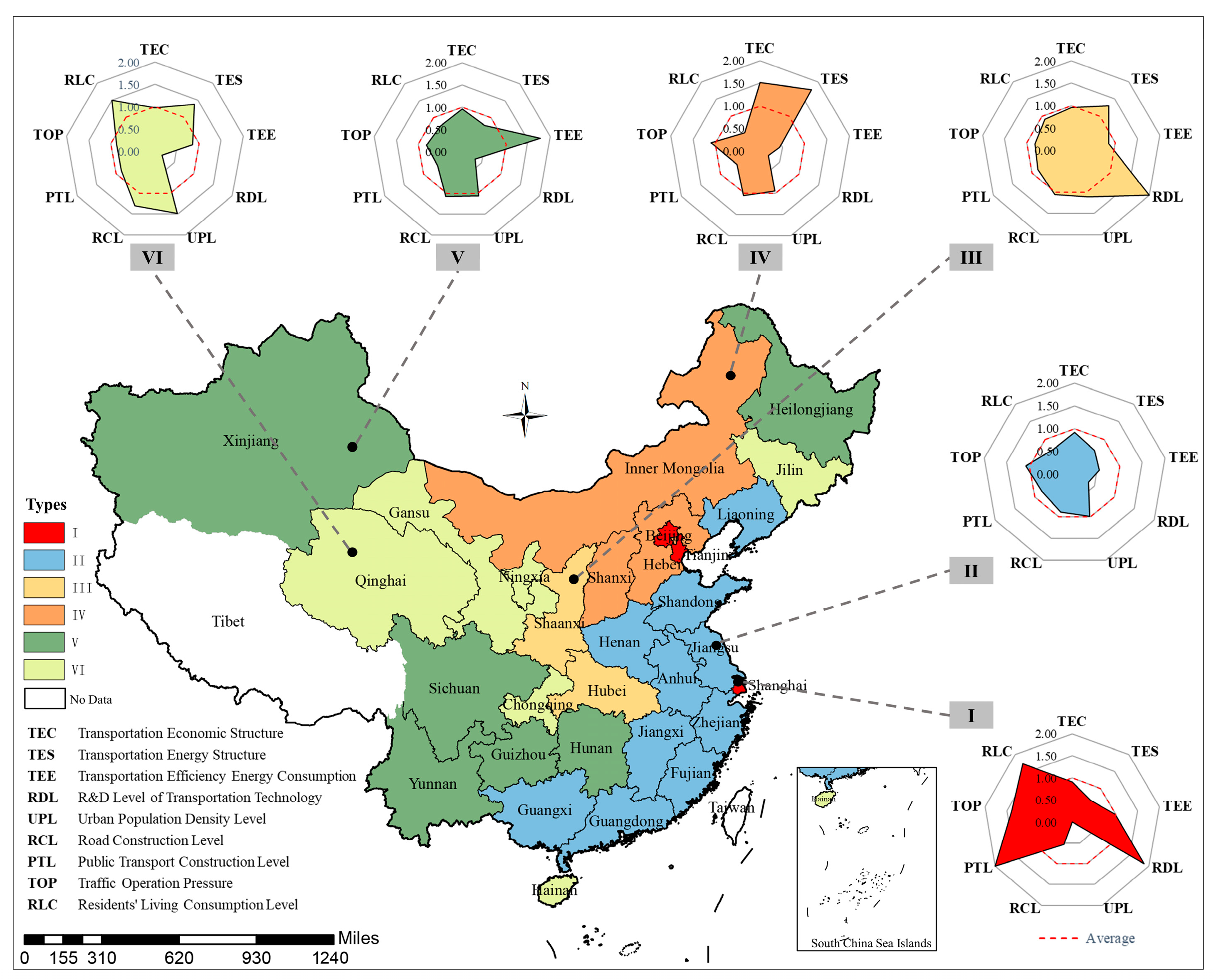

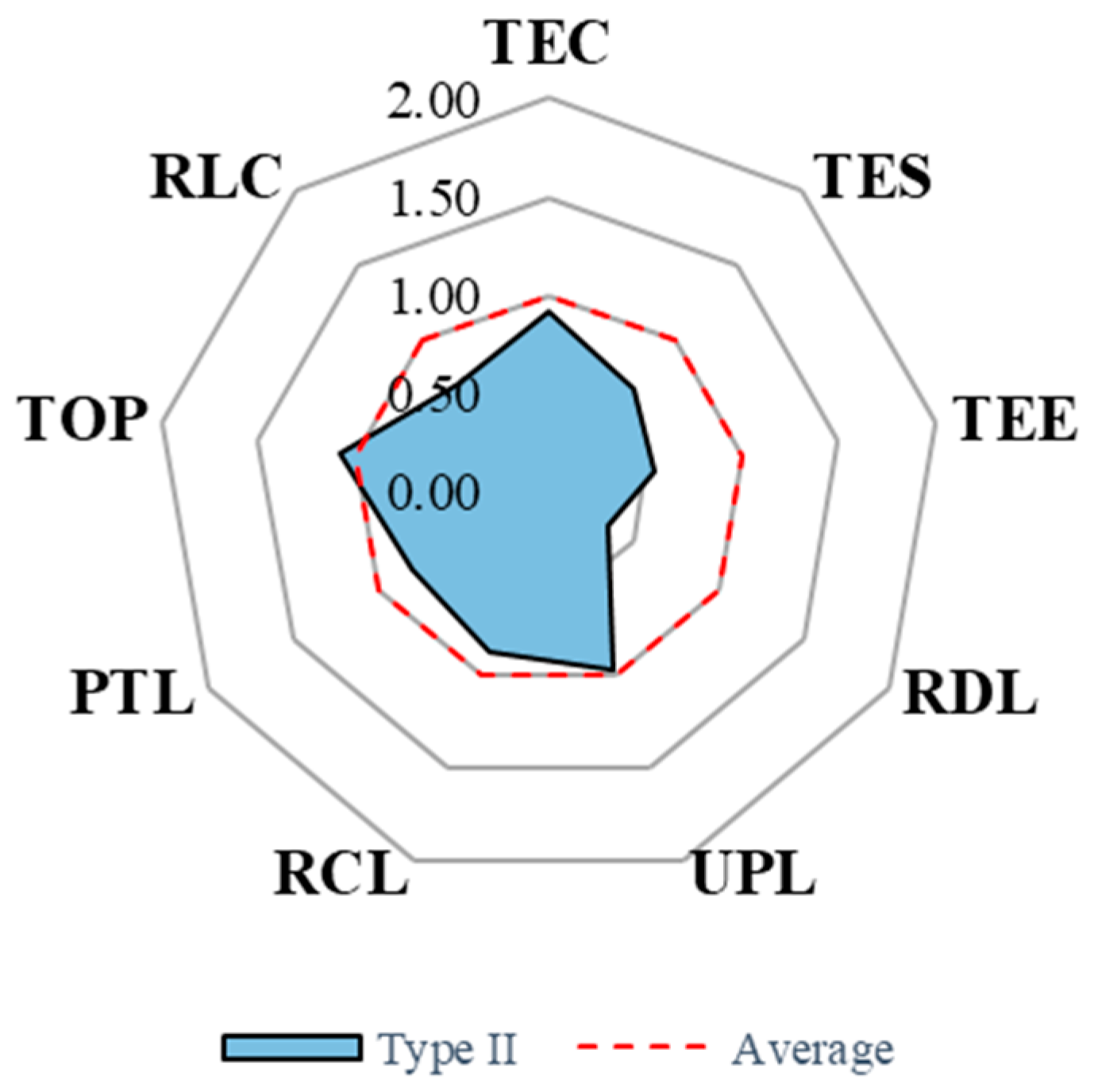
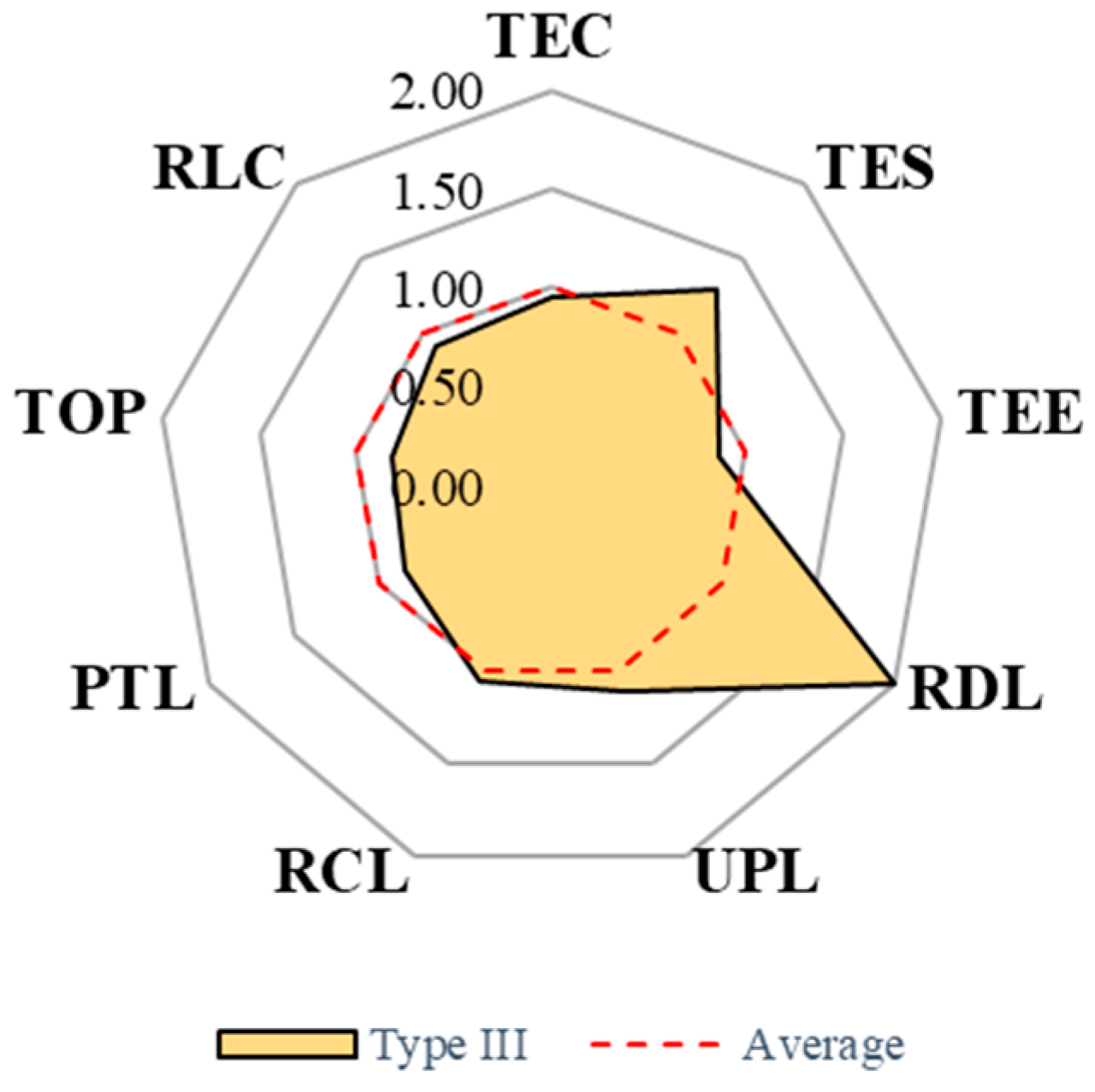
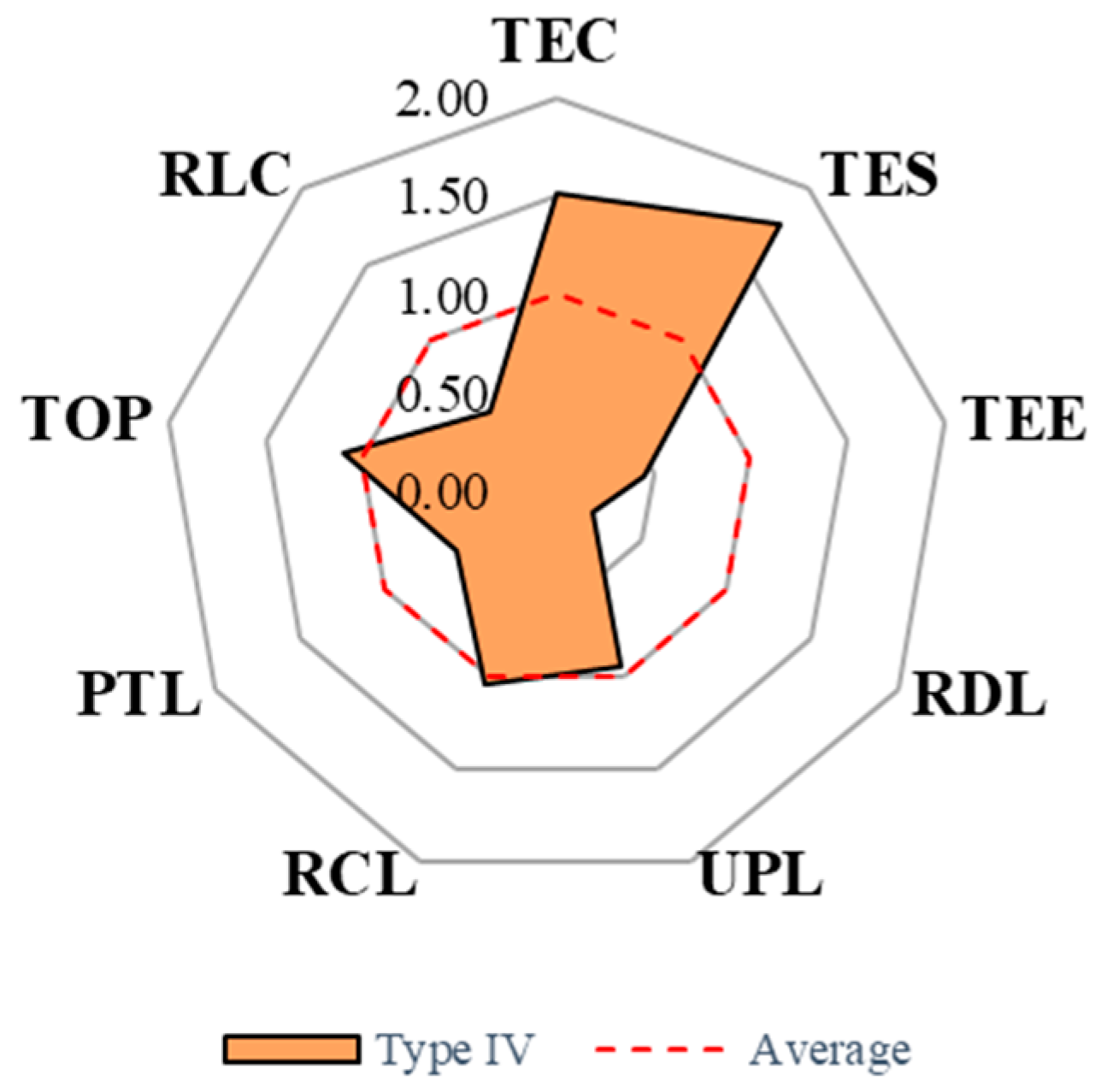

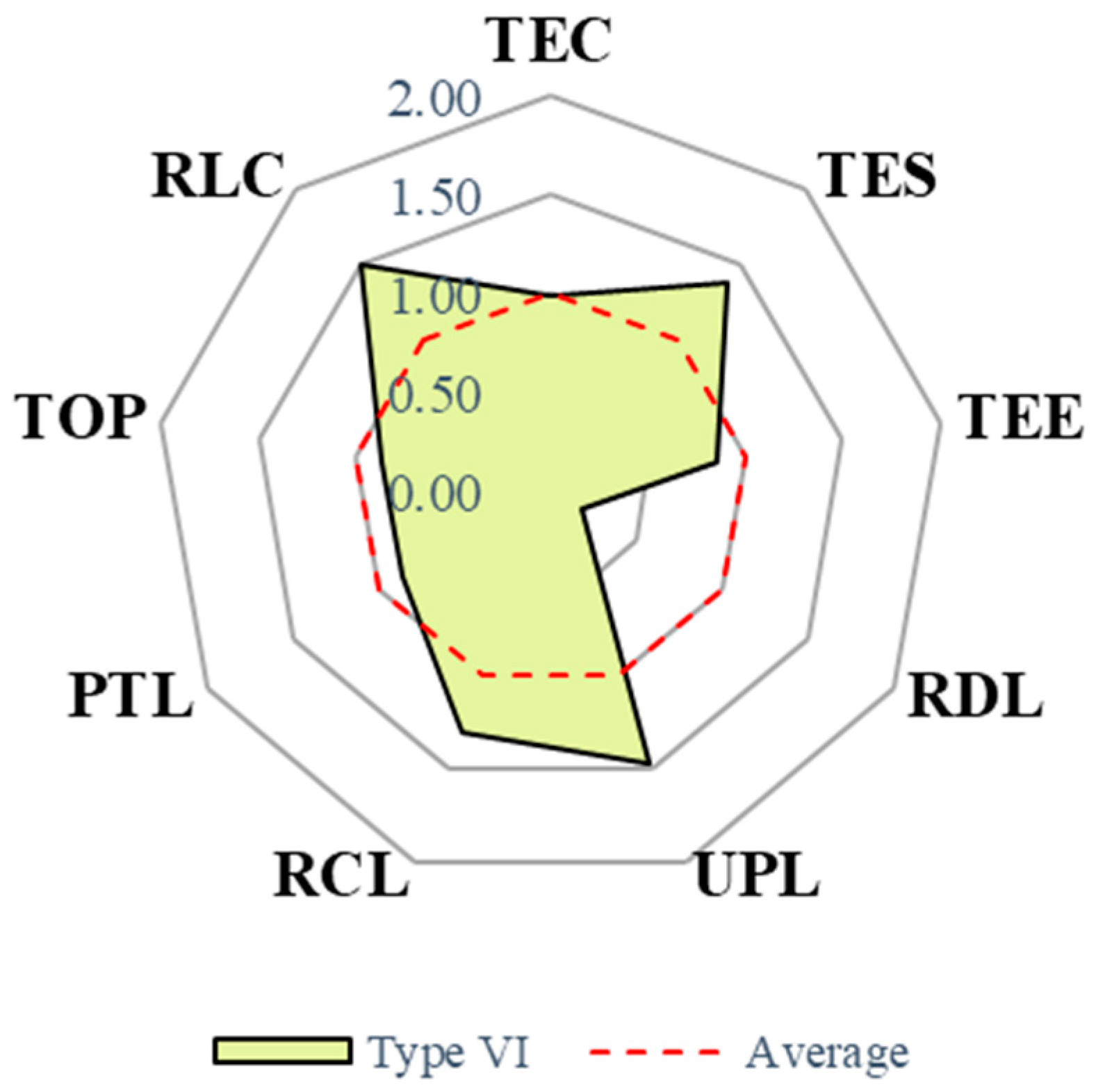
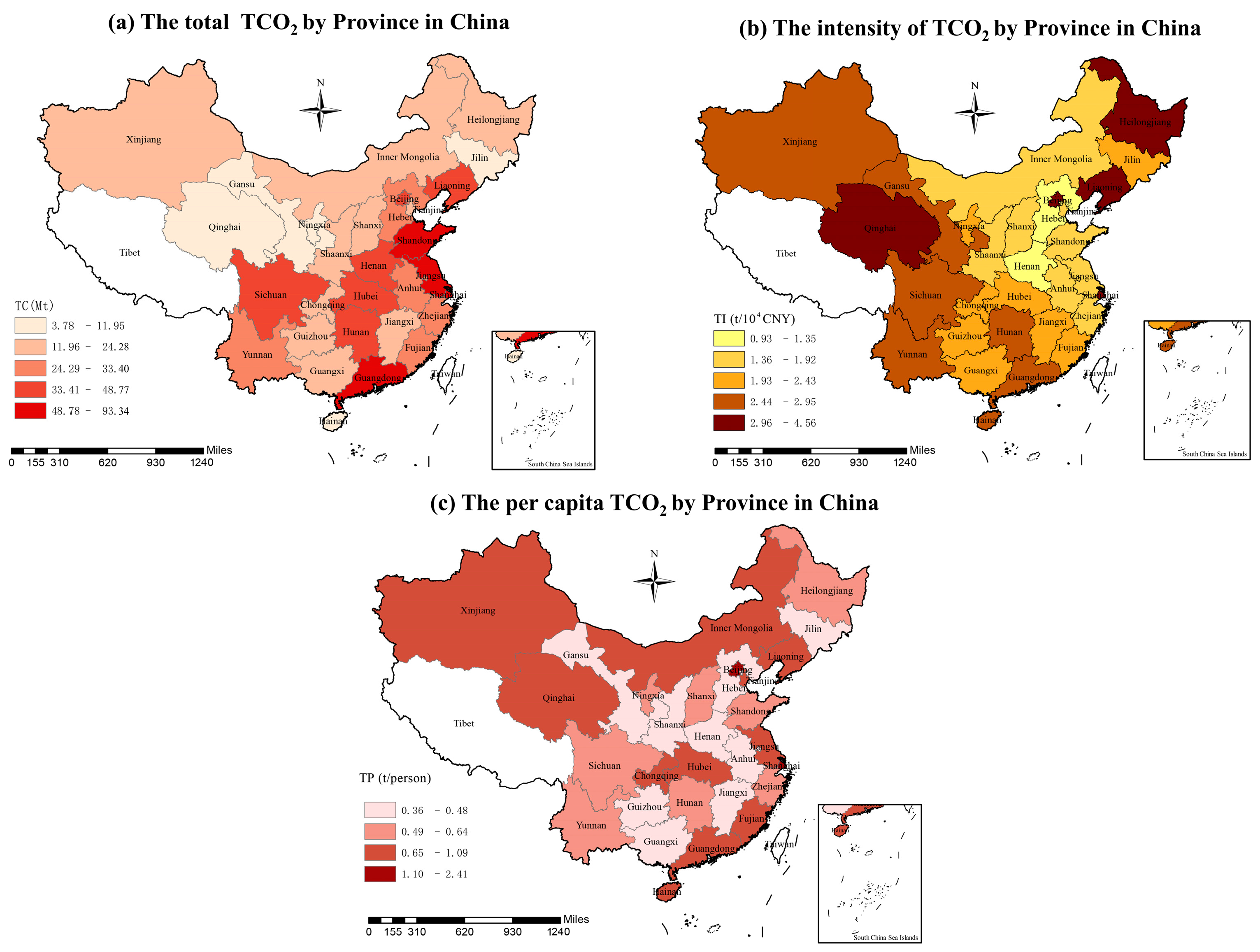
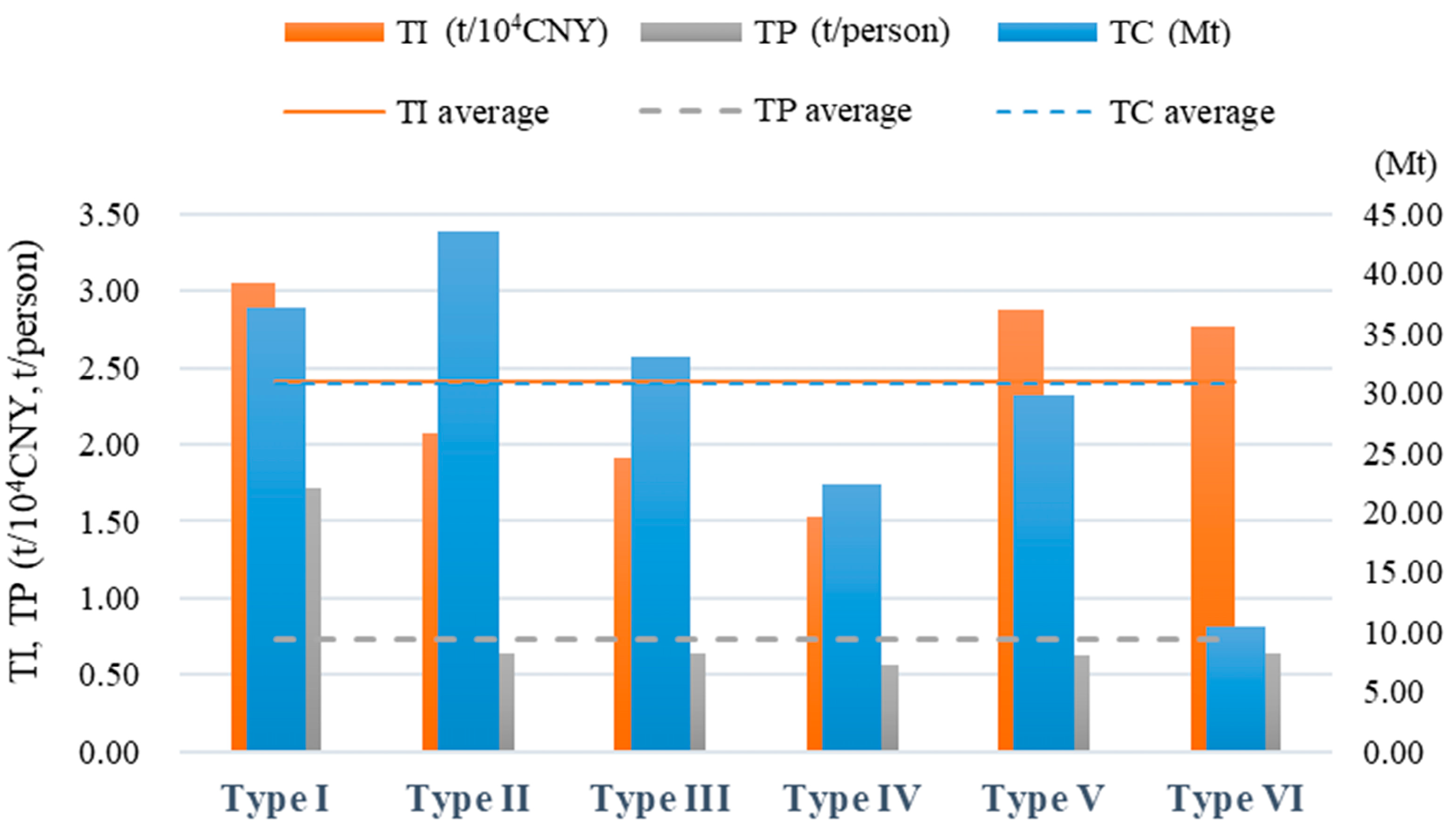
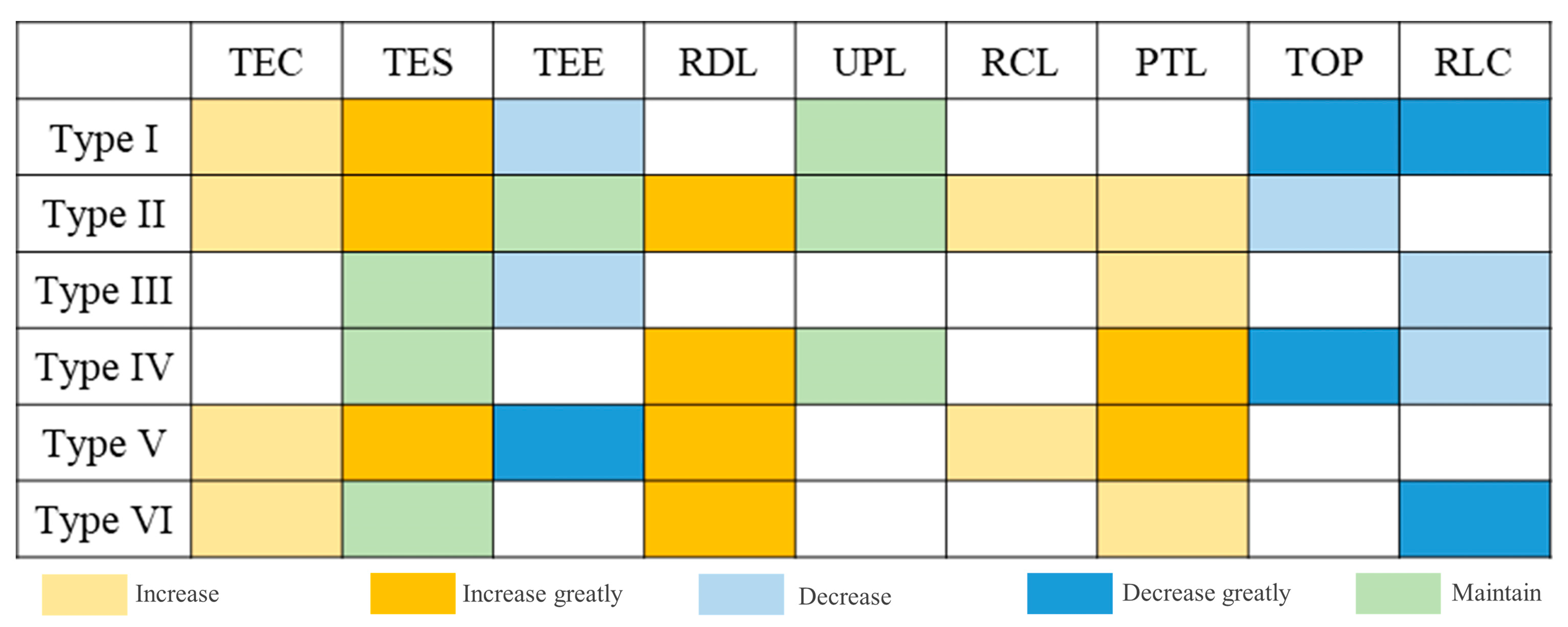
| Influence Factors | Indicator Name and Abbreviation | Indicator Description | Indicator Expression and Parameter Definition |
|---|---|---|---|
| Transportation economic output intensity | Transportation economic structure (TEC) | compared to the provincial average. | is the added value of the transportation sector in province , is the gross domestic product of province , is the provincial average value of the numerator. |
| Transportation energy structure | Transportation energy structure (TES) | compared to the provincial average. | is the consumption of clean energies such as electricity and natural gas in the transportation sector of province , is the total energy consumption of transportation in province , is the consumption of “gasoline” and “diesel oil” in “residential life” of province , is the provincial average value of the numerator. |
| transportation energy intensity | Transportation energy consumption efficiency (TEE) | compared to the provincial average. | is the total transportation turnover is the provincial average value of the numerator. |
| R&D level of transportation technology (RDL) | compared to the provincial average. | is the internal expenditure on R&D funds for the transportation sector in province , is the year-end population of province , is the provincial average value of the numerator. | |
| Population factor | Urban population density level (UPL) | Reflects the level of the gap between the population density of urban and county in province compared to the provincial average (lower values indicate higher urban population density). | is the county population density of province , is the urban population density of province , is the provincial average value of the numerator. |
| Transportation infrastructure construction | Road construction level (RCL) | compared to the provincial average. | is the actual urban road length by year-end of province , is the urban population by year-end of province , is the highway mileage of province , and are the provincial average values of each numerator. |
| Public transportation construction level (PTL) | compared to the provincial average. | is the number of operating buses and trolley buses in cities of province , is the number of rail transit vehicles assigned in province , is the number of taxis in province , , , and are the provincial average values of each numerator. | |
| Transportation pollution intensity | Traffic operation pressure (TOP) | compared to the provincial average. | is the private car ownership in province , is the sum of road traffic congestion in province . , and are the provincial average values of each numerator. |
| Pollution intensity of resident transportation behaviors | Residents’ living consumption level (RLC) | compared to the provincial average. | is the total resident consumption expenditure of province , is the passenger volume of province . , and are the provincial average values of each numerator. |
| Type | TEC | TES | TEE | RDL | UPL | RCL | PTL | TOP | RLC |
|---|---|---|---|---|---|---|---|---|---|
| Type I | 0.91 | 0.65 | 0.99 | 1.87 | 0.00 | 0.54 | 2.00 | 1.39 | 1.73 |
| Type II | 0.91 | 0.68 | 0.55 | 0.35 | 0.97 | 0.88 | 0.80 | 1.08 | 0.72 |
| Type III | 0.96 | 1.29 | 0.86 | 2.00 | 1.11 | 1.05 | 0.85 | 0.82 | 0.92 |
| Type IV | 1.51 | 1.77 | 0.45 | 0.21 | 0.94 | 1.05 | 0.59 | 1.10 | 0.53 |
| Type V | 0.96 | 0.78 | 1.77 | 0.34 | 1.06 | 1.08 | 0.64 | 0.81 | 0.76 |
| Type VI | 0.98 | 1.38 | 0.86 | 0.18 | 1.47 | 1.30 | 0.86 | 0.87 | 1.50 |
| Type | TC (Mt) | TI (t/104 CNY) | TP (t/Person) |
|---|---|---|---|
| Type I | 37.15 | 3.05 | 1.71 |
| Type II | 43.47 | 2.07 | 0.63 |
| Type III | 33.06 | 1.91 | 0.64 |
| Type IV | 22.41 | 1.53 | 0.56 |
| Type V | 29.89 | 2.88 | 0.63 |
| Type VI | 10.49 | 2.76 | 0.64 |
| Provincial average | 30.73 | 2.40 | 0.73 |
| Province | TC/TC Average | TI/TI Average | TP/TP Average | Priority Control Directions for Carbon Reduction |
|---|---|---|---|---|
| Type I | 1.21 | 1.27 | 2.33 | TP control |
| Type II | 1.41 | 0.86 | 0.86 | TC control |
| Type III | 1.08 | 0.79 | 0.87 | TC control |
| Type IV | 0.73 | 0.63 | 0.77 | TP control |
| Type V | 0.97 | 1.20 | 0.85 | TI control |
| Type VI | 0.34 | 1.15 | 0.87 | TI control |
| RDL | UPL | PTL | TOP | RLC | ||
|---|---|---|---|---|---|---|
| TP | Pearson correlation | 0.857 ** | −0.567 ** | 0.842 ** | 0.485 ** | 0.498 ** |
| Sig. (2-tailed) | 0.000 | 0.001 | 0.000 | 0.007 | 0.005 | |
| N | 30 | 30 | 30 | 30 | 30 |
| UPL | PTL | TOP | RLC | ||
|---|---|---|---|---|---|
| RDL | Pearson correlation | −0.569 ** | 0.880 ** | 0.498 ** | 0.437 * |
| Sig. (2-tailed) | 0.001 | 0.000 | 0.005 | 0.016 | |
| N | 30 | 30 | 30 | 30 |
| TEC | TEE | PTL | RLC | ||
|---|---|---|---|---|---|
| TI | Pearson correlation | −0.415 * | 0.528 ** | 0.386 * | 0.501 ** |
| Sig. (2-tailed) | 0.023 | 0.003 | 0.035 | 0.005 | |
| N | 30 | 30 | 30 | 30 |
| TEE | UPL | RCL | TOP | RLC | ||
|---|---|---|---|---|---|---|
| PTL | Pearson correlation | 0.439 * | −0.625 ** | −0.384 * | 0.607 ** | 0.573 ** |
| Sig. (2-tailed) | 0.015 | 0.000 | 0.036 | 0.000 | 0.001 | |
| N | 30 | 30 | 30 | 30 | 30 |
Disclaimer/Publisher’s Note: The statements, opinions and data contained in all publications are solely those of the individual author(s) and contributor(s) and not of MDPI and/or the editor(s). MDPI and/or the editor(s) disclaim responsibility for any injury to people or property resulting from any ideas, methods, instructions or products referred to in the content. |
© 2023 by the authors. Licensee MDPI, Basel, Switzerland. This article is an open access article distributed under the terms and conditions of the Creative Commons Attribution (CC BY) license (https://creativecommons.org/licenses/by/4.0/).
Share and Cite
Yang, Y.; Yan, F. An Inquiry into the Characteristics of Carbon Emissions in Inter-Provincial Transportation in China: Aiming to Typological Strategies for Carbon Reduction in Regional Transportation. Land 2024, 13, 15. https://doi.org/10.3390/land13010015
Yang Y, Yan F. An Inquiry into the Characteristics of Carbon Emissions in Inter-Provincial Transportation in China: Aiming to Typological Strategies for Carbon Reduction in Regional Transportation. Land. 2024; 13(1):15. https://doi.org/10.3390/land13010015
Chicago/Turabian StyleYang, Yuhao, and Fengying Yan. 2024. "An Inquiry into the Characteristics of Carbon Emissions in Inter-Provincial Transportation in China: Aiming to Typological Strategies for Carbon Reduction in Regional Transportation" Land 13, no. 1: 15. https://doi.org/10.3390/land13010015





